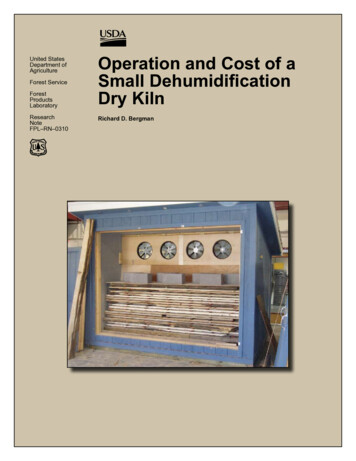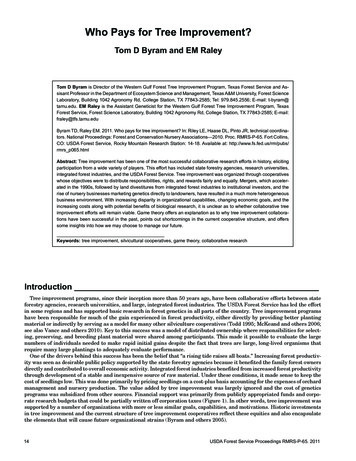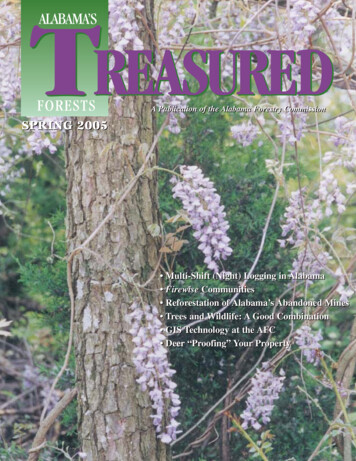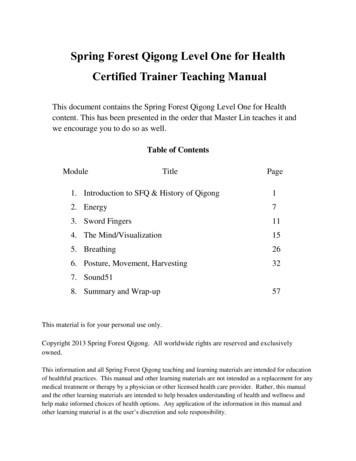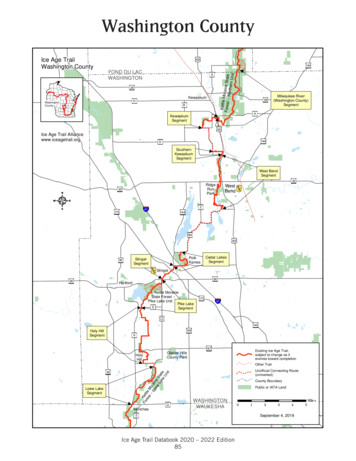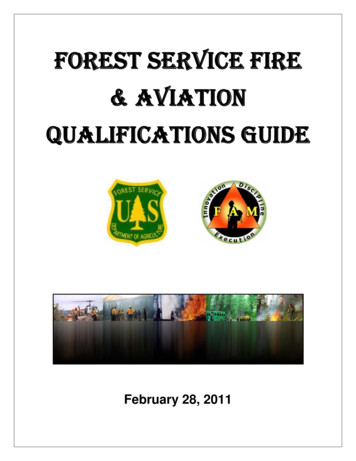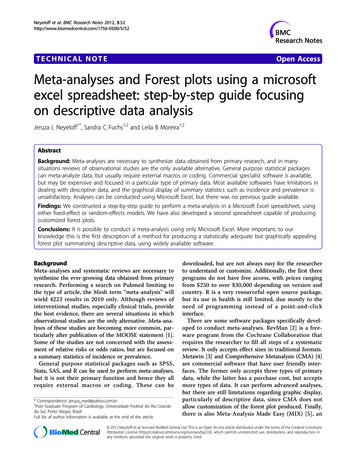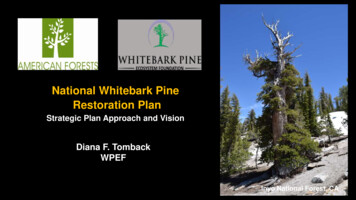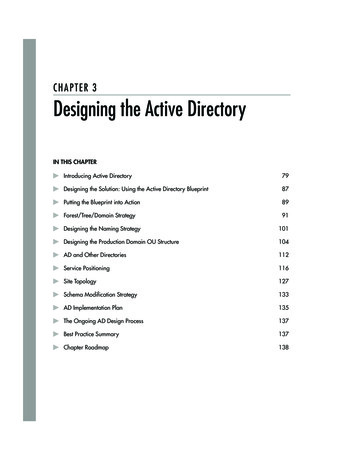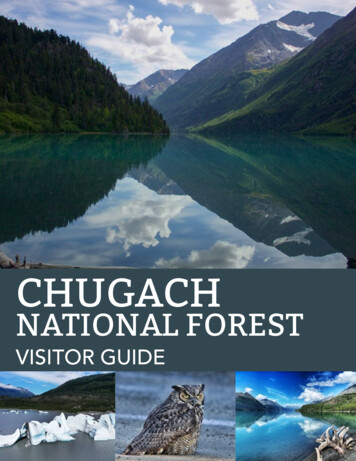
Transcription
CHUGACHNATIONAL FORESTVISITOR GUIDE
Table of ContentsOVERVIEW. 3EASTERN KENAI PENINSULA. 5PRINCE WILLIAM SOUND. 7COPPER RIVER DELTA. 9CABINS. 10CAMPGROUNDS. 11TRAIL GUIDE. 12WILDLIFE. 13BEARS. 14BACKCOUNTRY GUIDE. 15VISITOR CENTERS. 15ACTIVITIES FOR KIDS. BACK COVERWelcome to theChugach National ForestA breathtaking landscape in the heart ofsouthcentral Alaska.The Chugach is the backyard for more than half of Alaska’s residents and is acoveted destination for hundreds of thousands of visitors each year.The most northerly and westerly forest in the National Forest System, the 5.4million-acre Chugach National Forest is composed of three distinct landscapesand compares in size to the state of New Hampshire. The Forest is home to manyof Alaska’s Native peoples, including Ahtna, Chugach, Dena’ina, and Eyak.Chugach National Forest hosts more than half a million visitors each year.Visitors explore the 3,500 miles of shoreline in Prince William Sound, the glacierstudded Nellie Juan-College Fiord Wilderness Study Area, the Kenai Peninsula’s175-miles of the Iditarod National Historic Trail-Southern Trek, or the CopperRiver Delta, the largest contiguous wetlands complex on America’s Pacific coastand a spring migration stopover for millions of shorebirds.While portions of Alaska are often considered remote, the Chugach is accessiblethrough multiple routes. More than 500 miles of trails, 40 cabins, and 16campgrounds provide plenty of opportunities to explore, making it a populardestination for those wanting to leave the bustle of the city behind.During the summer, our two visitor facilities – Begich, Boggs Visitor Center andCrooked Creek Information Site – showcase the cultural and natural history ofthe Forest. When the facilities are open, Forest Service staff lead guided hikes,discuss natural history aboard the MV Ptarmigan on Portage Lake, and point outareas of interest on Alaska Railroad trips to the popular Spencer and GrandviewWhistle Stops.Spectacular fishing draws Alaskans and tourists to the Forest, where all fivespecies of Pacific salmon can be caught in its pristine waters. The Forest’s 48,000acres of lakes and 1,800 miles of streams produce 66 million salmon a year or 11%of Pacific salmon production.The Forest issues approximately 250 permits annually for activities such asguided summer and winter recreation, fishing, hunting, flightseeing, boatcharters, rafting and kayaking, bird watching, scenic tours, and wildlife viewing.We urge you to take advantage of the nearly 120 permitted outfitters and guidesto further your connection and experiences on the forest.This visitor guide is an overview of opportunities and facilities available on theChugach National Forest. Enjoy exploring your National Forest.Jeff SchrammForest Supervisor, Chugach National ForestAlaska RegionCoordinated and written by Annette Heckart and Mona SpargoMaps created by Fay Dearing & Charles LindemuthAll photos are courtesy USFS unless otherwise notedCover photo by Jenelle WempnerDesigned by Timberdoodle Studio
Get Out and Explore!There’s something for everyone on the Chugach National Forest.From the Kenai Peninsula to Prince William Sound, to the easternshores of the Copper River Delta, the Forest is full of specialplaces. Whether you have an hour or several days there areoptions galore for exploring. Here are just a few to get started.IF YOU HAVE ACOUPLE OF HOURS:IF YOU HAVE ACOUPLE OF DAYS:KENAI PENINSULAKENAI PENINSULAVisit the Begich, Boggs Visitor Center& Portage Valley An hour’s drive south of Anchorage Engaging exhibits and 20 minute film View salmon spawning at Williwaw FishViewing Platform Try your hand at the Agents of DiscoveryPortage Valley MissionPRINCE WILLIAM SOUNDGo flightseeing Experience the vast bounty of the Sound See magnificent glaciers sculpt the landscape Breathtaking sceneryCOPPER RIVER DELTAHike the Eyak River TrailHike the Resurrection Pass Trail Designated a National Recreation Trail 38 mile trail with eight rental cabins and camping spotsalong the route Varied terrain from thick forest to alpine meadowsPRINCE WILLIAM SOUNDTake a Kayak Trip in Prince William Sound Practice your kayaking skills Observe busy bird rookeries View sea life up closeCOPPER RIVER DELTATake in a Festival Copper River Delta Shorebird Festival Cordova Salmon Jam Fungus Festival 2.9 mile trail begins along the Eyak River A wonderful variety of forest landscapes Popular access site for anglers duringthe coho salmon runsSAFETY MESSAGEThe Chugach National Forest asks the publicto please recreate responsibly. We encourageyou to follow public health guidelines regardingsocial distancing while you recreate in NationalForests.Please visit our website for the latestinformation related to COVID safety protocolsand up-to-date information on openings orclosings of recreation facilities and trails.For more information about how the ForestService is responding to COVID-19, click here.No permits are required for noncommercial use of Forest trails orbackcountry camping.3
Crow PassTrail – INHTToAnchora gCrow PassCabineUpper Winner CreekTrail - INHTSewardHighwayGull RockTrailGlacier ,BoggsVisitor CenteronPadGrandviewWhistleStopskar a ilAlaCrescent Crk.nt Cr kscereQuartz Crk.ilCrescentSaddleTra ilsuReAspenFlatsUpperRussianLakeTrail ilRiverTrLost LakeTrailExitGVictor CreekTrailUpperParadiseLakeLowerParadiseLakeBear LakeTrail - INHTailResurrectionRiverL ake TrailMeridian LakeTrail - INHTnrrectiongaRui an LksraCarterLake rest BoundaryNellie Juan-College Fiord Wilderness Study AreaDaleClemenslacGlaciers and perm iceRoadsLandownerier Rd.Chugach National ForestKenai Fjords National Park0 2.5 5042.5Portage PassTrail - INHTSpencerBenchJohnsJuneauLakeing HwySterlssTenderfootCreekC rkvil’SDeSwan LakeWilliwawSpencerWhistleStopGraniteCreekr e e k rthaCreekassWest SwanLakeRomigainFoxCreeke Ic –e INHTBlackBearTr ail - INHTResurrCaribouCreekEastCreekHTasson- INutiecTrailofBlPas s TrailCoeurd’AleneHope High w laska RailroadTrailsRanger StationForest Service CampgroundsForest Service CabinsKenai National Wildlife RefugeWhistle StopState, municipal, private, or Native landsAgents of DiscoveryPortage Valley MissionChugach State Park
Eastern Kenai PeninsulaThe Eastern Kenai Peninsula in the Chugach NationalForest is best known for its ease of access and spectacularrecreational opportunities. Its forested lands, mountains,and rivers begin just 45 minutes south of Anchorage, thelargest city in Alaska, via the scenic Seward Highway.The Peninsula is a place of almost unlimited possibilities.It boasts hundreds of miles of maintained trails and thenumerous creeks and rivers offer great opportunities to reelin “the big one.” The Eastern Kenai Peninsula truly holdssome of the Forest’s most accessible treasures.CAMPINGNumerous camping opportunities exist all along theSeward Highway, a nationally designated All-AmericanRoad. A popular campground for large groups, TrailRiver, is strategically located south of Moose Pass. It canaccommodate modern recreational vehicles and has a dayuse area along the scenic shore of Kenai Lake. A group site,available by reservation, has a volleyball area, horseshoearea, covered pavilion with fire grates, andplayground equipment.CHUGACH WHISTLE STOPThrough the Chugach Whistle Stop partnership betweenthe Chugach National Forest and the Alaska RailroadCorporation visitors have a distinctive travel and recreationexperience found nowhere else in the United States. TheGlacier Discovery Train takes you into the backcountryof the Forest to Spencer and Grandview Whistle Stops.At Spencer a trail leads to a spectacular view of SpencerGlacier. For those looking to overnight, camping optionsinclude a group campsite, dispersed camping outsidethe developed recreation area, and the Spencer BenchCabin. (Reservations required for group site and cabin.)At Grandview there is a short interpretive trail wherepassengers can stretch their legs before boarding the trainto return to Portage and Anchorage. So climb aboard andexperience the Chugach National Forest backcountry.DON’T MISS.IDITAROD NATIONAL HISTORICTRAIL — SOUTHERN TREKThe Chugach National Forest and partners are workingto restore and develop more than 180 miles of theSouthern Trek of the Iditarod National Historic Trail(INHT), connecting the communities of Seward, MoosePass, Whittier and Girdwood. The trail represents anational heritage, recreation, and education resourcethat inspires and draws Iditarod enthusiasts, historybuffs, students, and outdoor adventurers from aroundthe world. Located less than an hour from Anchorage,the Southern Trek provides year-round opportunities toexperience the spirit of the historic Iditarod.5
NELLIE JUAN –COLLEGE FIORDWILDERNESSSTUDY AREAValdezCoghill LakeCrooked CreekInformation SiteHarrison LagoonJack BayPigot BayWhittierPaulsonBayShrode LakeCordovaRangerDistrictDouble BayShelter BayGreen IslandHook PointPort ChalmersBeach RiverNellie MartinRiverLog Jam BaySan Juan Bay605 10052010302040Kilometers30Forest BoundaryRoadsNellie Juan-College Fiord Wilderness Study AreaAlaska RailroadGlaciers and perm iceLandownerChugach National ForestBureau of Land ManagementState, municipal, private or Native lands40MilesRanger StationForest Service Campgrounds
Prince William SoundThe forest meets the sea in Prince William Sound, wherelush rainforest borders 3,500 miles of intricate coastline.Visitors in a variety of watercraft and floatplanes explorethe sparkling waters and nearly three million acres offorest. A day cruise or flightseeing trip are excellent waysto see the vast area and wildlife of the Sound. Hundredsof glaciers spill from high peaks, some flowing all the wayto the ocean and calving into remote fiords. Retreating iceprovides a glimpse of the area’s unique geology andpost-glacial reforestation.Permits are not required for non-commercial campingand all campsites are primitive. Contain camping activitiesto beach gravel surfaces and clean up bits of garbage,dismantle fire rings, and replace moved rocks or materials.Four campsites in Blackstone Bay and Culross Passageprovide durable gravel camping surfaces. Bear cans areavailable at the Glacier Ranger District.EXPLORING THE WSAIn 1980, Congress designated roughly two million acresalong western Prince William Sound as the NellieJuan-College Fiord Wilderness Study Area (WSA). Thisrecognized the area’s exceptional beauty and remotenessand its possible future designation as federal Wilderness.The Forest Service maintains the area’s presently existingcharacter to provide the public outstanding opportunitiesfor solitude, primitive recreation, and inspiration in anundeveloped setting. Fishing, hunting, hiking, kayaking,skiing, camping, birding, and many other non-motorizedactivities are encouraged. The WSA only pertains tonational forest system lands and does not affect uses onmarine waters.RECREATING IN THE SOUNDUnplug from daily life! Enjoy kayaking, boating, glacierand marine life viewing. Established trails are few but thehiking is beautiful and short treks reach alpine areas andgreat views. For overnight stays, spend days exploring thealpine slopes, berry-picking, fishing, hunting, or skiing inwinter, and evenings at a beach campsite. Always practiceLeave No Trace principles (visit lnt.org), and followrestrictions if you are in the WSA.DON’T MISS.A TRIP TO PRINCE WILLIAM SOUNDEnjoy viewing busy bird rookeries, sea life, andbreathtaking scenery. Plan a multiple day trip to accessremote campsites and cabins around the Sound.Be prepared! Help can be hours away. Review tide, bear,and water safety information before heading out, ascommunications may be non-existent. If you’re notcomfortable heading out on your own, check out localtour operators providing guided adventures in the Sound.7
ChildsGlacierPowerCreekEyakLakeMcKinleyLake vaRangerDistrictCopperRiverMcKinleyAlaganik TrailSloughCopperRiverDeltaSoftukBar100 2.5 51520Kilometers101520MilesChugach National ForestWrangell-St. Elias National Park and PreserveBureau of Land ManagementState, municipal, private, or Corporation landsForest BoundaryGlaciers and perm ice8RoadsRanger StationForest Service CampgroundsForest Service CabinsWildlife ViewingAgents of DiscoveryHaystack Trail MissionKayak0 2.5 5ndlaIs* The bridge near Mile 36 has been closedby Alaska DOT&PF, and Childs Glaciercampground can no longer be accessedvia the Copper River Highway. Apermittee is available to providetransportation for a fee.
Copper River DeltaThe 700,000 acre Copper River Delta is the largestcontiguous wetlands along the Pacific coast of NorthAmerica, named for abundant copper deposits which havedrawn people to the river’s edge for centuries. Woven fromsix glacial river systems, the Delta is renowned for its vastwetland habitats, mountains, and glaciers—with Milesand Childs Glaciers calving directly into the Copper River.Unconnected by roads, you must take a boat, ferry, or planeto Cordova in order to access the Delta.The Delta is managed for the conservation of fish andwildlife and their habitats. Bear, moose, Bald Eagles, andmountain goats are frequently sighted, making wildlifeviewing very popular. More than two million salmonspawn in the river each year, traveling almost 300 milesto return to spawning grounds. The high concentration ofomega-3 fatty acids required for the journey make thesefish a favorite of cooks and chefs the world over.ALAGANIK SLOUGHAlaganik Slough is a unique wildflower viewing area situatedon the expansive Copper River Delta. The three-mile roadaccessing Alaganik Slough from the Copper River Highwaywinds through species-rich wetlands and ponds supportingboth aquatic and terrestrial plants. At the end of the roadyou will find a developed site including a 900-foot accessibleboardwalk with a covered viewing platform. The best timeto catch wildflowers in bloom is June - July. Alaganik Sloughalso has fishing for Dolly Vardon, coho salmon and hooliganfrom spring to fall.DON’T MISS.COPPER RIVER DELTASHOREBIRD FESTIVALBIRDINGThe Delta is for the birds — literally. Swans, geese,ducks, shorebirds, and Bald Eagles are all temporary orpermanent inhabitants of the area. Birds flock here to takeadvantage of lands set aside as nesting grounds and torefuel and rest on their way through the North Americanflyway. The Delta is an integral part of the WesternHemisphere Shorebird Reserve Network, which bringstogether organizations to recognize and protect criticalshorebird habitat.The most inviting small town in Alaska just may beCordova, a fishing community and birder’s paradise.The first weekend in May, the community welcomesmillions of shorebirds to the Copper River Delta.Community events, workshops, and educationalopportunities are offered throughout the week. Travel toCordova from Anchorage by air or by ferry from Whittieror Valdez. More information is available from theCordova Chamber of Commerce (cordovachamber.com)9
Cabins in the ChugachA stay in one of the Forest’s 40 primitive (no electricity or running water)cabins can be a great way to explore the backcountry and have shelter from theelements. The cabins are located in a variety of landscapes across the Forest.Cabins along lakes and streams may have rowboat and oars providing a greatway to extend your exploration or access a fishing spot. The McKinley Trail cabinin Cordova is the only drive-up cabin on the Forest.COST:STAY LIMIT:GET THERE: 50- 100 a night.3-7 nights summer; 7 nights winter.Hike, paddle, charter a plane or boat.HEAT:Woodstove and/or oil stove. Check before you go: some cabinsrequire you to bring your own fuel.BRING:Sleeping bags and pads, cook stove and gear, first aid, water,food, insect repellent, extra food, and clothing.EMERGENCY:There are no phones or radios. Cell phone coverage is notguaranteed. Be prepared.RESERVATIONSCabins are rented at recreation.gov or 1-877 444-6777 and can be reserved up to180 days in advance.Dale Clemens CabinTo reserve the Spencer Bench Cabin in the summer season, mid-June–mid Sept.,call the Alaska Railroad 1-800-544-0552.CABIN HIGHLIGHTSTROUT LAKE CABINThis large, rustic cabin sits on the eastern shore of TroutLake, just 7.8 miles off the Sterling Highway. It is the first of aseries of cabins on the 38-mile Resurrection Pass Trail Southand a nice-first night stay if you are hiking the entire trailor a good home base for exploring or hunting and fishing (inseason). Surrounded by willow, spruce, and birch trees andopen brushy areas, there are great views of the lake and thesurrounding mountains. The cabin sleeps seven and has arowboat for puttering around the lake. The cabin is heated bywood stove. It can be reached by floatplane or trail.PIGOT BAY CABINTucked away in Prince William Sound, this A-frame cabinis on a dense evergreen forested bluff overlooking PigotBay. Accessible only by float plane or boat, there is a steepstaircase from beach to cabin. Hiking is limited, but a kayakcan expand your explorations into the Bay and surroundingwaters. Wildlife is commonly sighted and pink salmonfishing is possible in late July – early August. Supplementyour camp meal with abundant blueberries and raspberriesfrom the area. The cabin is heated with a kerosene stove andvisitors need to provide their own fuel.10SOFTUK BAR CABINLocated 45 miles southeast of Cordova on the Gulf ofAlaska, this remote cabin sleeps six and is a scenic settingfor hunting, birding, clamming, berry picking, and wildlifeviewing. The sandy beach adjacent to the cabin is a greatplace for beachcombing in the springtime. Access to this siteis a 25-minute flight from Cordova by wheel plane. The cabinis surrounded by alder and spruce forest and glacier cappedpeaks. Softuk Bar Cabin has both wood and kerosene stovesfor heat; visitors need to provide their own fuel.Pigot Bay Cabin
Camping in the ChugachCampground LocationCAMPGROUNDSCampgrounds are generally open from mid-May through mid-September,with stays limited to 14 days except for the Russian River Campground(3-day limit June 10 – August 20). Most campgrounds have a few sites forlarge RVs. Quartz Creek and Williwaw are able to handle 60-foot RVs. Backcountry camping is permitted but limited to 14 days in one area. There areno water or electrical hookups.Campgrounds on the Kenai Peninsula and Portage/Turnagain Pass area areoperated by Alaska Recreation Management under permit from the ForestService. Coeur D’Alene and Childs Glacier Campground are operated by theForest Service.CAMPGROUND REGULATIONSSTORE ALL FOODS, beverages, garbage, pet food, and cooking or food# SitesKENAI PENINSULACoeur d’ Alene4Cooper Creek26Crescent Creek9Porcupine34Primrose8Ptarmigan Creek16Quartz Creek45Russian River83Tenderfoot Creek35Trail River91storage equipment in a vehicle, food locker, or camper.PORTAGE/TURNAGAIN PASSFIRES are allowed only in established grates. Cutting live vegetation orBertha12Black Bear12Granite Creek19Williwaw60standing deadwood is prohibited.PETS must be on a leash at all times. Please dispose of feces in garbagecans. Secure pet food inside a vehicle.DO NOT FEED any wild animal, even birds.RESERVATIONSFor campground reservations call (877) 444-6777 or recreation.gov.Fees range from free for remote sites to 30 depending on campground, and 150 for a large group site.COPPER RIVER DELTAChilds Glacier campground cannot beaccessed via the Copper River Highwaydue to a bridge closure. Contact theCordova Chamber of Commerce foroptions to access the area.FIRE SAFETY Keep campfires small. Build campfires away fromoverhanging branches, steep slopes,and flammable materials. Pile extra firewood away fromthe fire. Keep plenty of water and a shovelon hand. Be sure any used matches are out. Never leave campfires unattended. Extinguish fires completely. Never bury a fire, the fire couldsmolder and catch roots on fire. Fires in Prince William Soundshould be built below the hightide zone. If you see a fire burning out ofcontrol call 911.11
Trail of Blue IceTrail GuideHiking HighlightsHOPE POINT TRAILThe Hope Point Trail has great views of Resurrection Creek Valley,Turnagain Arm, Cook Inlet, Fire Island and the Chugach Mountains. Thistrail makes a great day hike and adventurous hikers can head off-trail out toother summits in the Kenai Mountains for overnight hikes. The first mile isrelatively easy, but quickly increases in difficulty.HENEY RIDGE TRAILThis local favorite is a mere six miles outside the town of Cordova. As youmake your way through old-growth forest with massive moss-covered Sitkaspruce, you cross the oldest split log bridge in the area and begin your wayalong a series of switch-backs. Views from the switchbacks tantalize you asthey come in and out of focus. Two and a half miles later you are rewardedby views of Orca Inlet to the east. If you are still feeling strong, continueanother 1.5 miles for a knockout view of the Gulf of Alaska and Kayak Island.TRAIL OF BLUE ICEA walk in the woods that is fun for the whole family is waiting for you inPortage Valley. The wide trail allows for side-by-side strolling and hasaccessible, smooth surface gravel, pavement, or wood decking. The views arespectacular as you walk along the creek and through the glacial valley. Hikeor bike round-trip from Williwaw Fish Viewing Platform to Moose Flats orcustomize your trip with a 3-mile loop that begins and ends at Portage Lake.The trail is always open, but check-in at the Begich, Boggs Visitor Center fora map of the area and suggestions on customizing your walk.12For more trail, cabin and camping informationvisit fs.usda.gov/chugachKENAI PENINSULA TRAILSCarter Lake3.4Crescent Creek6.2Crescent Lake Trail8.1Devil’s Creek10.0Falls Creek3.9Grayling Lake Trail1.5Gull Rock5.7Bear Lake – INHT7.5Meridian Lakes – INHT8.3Johnson Pass – INHT23.0Lost Lake – INHT7.3Primrose – INHT7.5Ptarmigan Creek – INHT3.5Ptarmigan Lake3.6Rainbow Lake0.3Resurrection Pass39Resurrection River16.3Russian Lakes21.8Victor Creek – INHT2.3WHISTLE STOP TRAILSGrandview VistaSpencer ViewpointSpencer GlacierSpencer Bench Cabin0.21.33.05.4GIRDWOOD/PORTAGE TRAILSByron Glacier0.9Crow Pass – INHT4.0Gary Williams Moraine0.2Portage Pass – INHT2.0Trail of Blue Ice – INHT5.0Upper Winner Creek – INHT 9.0Williwaw Nature1.3Winner Creek – INHT3.5COPPER RIVER DELTA TRAILSAlaganik Boardwalk0.2Alaganik Slough0.4Alice Smith Intertie6.6Copper River1.2Crater Lake2.4Eyak River2.2Haystack0.8Heney Ridge3.7Lake Elsner6.0McKinley Lake2.4Muskeg Meander3.0Pipeline Lakes1.8Power Creek4.2Saddlebag Glacier3.1Sheridan Mountain2.9Mileage provided are one-way distances.INHT – Iditarod National Historic Trail
Watchable WildlifeAlthough it might seem as if you are alone in the backcountry, carefulattention to your surroundings may reveal that you have more companythan you thought. While wildlife can be found anywhere on the Forest, thefollowing sites are well-known favorites of wildlife and depending on theseason can be a reliable source of rich wildlife viewing.EASTERN KENAIPRINCE WILLIAM SOUNDLocated at the intersection of the Seward and Sterlinghighways at Milepost 37. This area hosts a myriad ofanimals, birds, and fish. Common Loons, Bald Eagles, andArctic Terns share the area with a variety of songbirdsand shorebirds. Beavers, river otters, muskrats, andsalmon ply the cold, clear waters of Tern Lake. Moose,Dall sheep, and mountain goats can be seen on thesurrounding mountains.Best viewing: spring/summer/fallLocated on the outskirts of Valdez at Mile 0.5 of the RichardsonHighway. Pink and chum salmon return to this clear waterstream each summer to spawn. Occasionally, black bears canbe observed feasting on returning fish. You can view the online “Fish Cam” from the comfort of your home in season.Best viewing: summer/fallTERN LAKEMOOSE FLATS DAY-USE SITECROOKED CREEK INFORMATION SITECOPPER RIVER DELTAHARTNEY BAYLocated at Mile 1.0 on the Portage Highway. This site hasa short boardwalk trail along several ponds. It is a goodsite to observe nesting waterfowl. Moose are also frequentvisitors to the area and the boardwalk makes a niceobservation post.Best viewing: spring/summer/fallLocated at the end of Whitshed Road, approximately 5 milessouth of Cordova. From mid-April to mid-May, visitors havethe opportunity to view whirling flocks of shorebirds as theyrest and refuel on their long journey northward. The rest of theyear brings a wide variety of songbirds and marine mammals.In late summer, pink and chum salmon return to spawn.Best viewing: spring/fall.WILLIWAW FISH VIEWING PLATFORMALAGANIK SLOUGHLocated at Mile 4 of the Portage Highway. Spawning sockeye,chum, and coho salmon arrive in late July and remainthroughout early fall. Visitors may also see a variety of localsongbirds, Bald Eagles, and black and brown bears.Best viewing: spring/summer/fallLocated at Mile 17 of the Copper River Highway. Anaccessible boardwalk leads visitors to stunning views of boththe expansive wetlands of the Copper River Delta and thesurrounding mountains. A wide variety of wetland animalsincluding Trumpeter Swans, moose, brown bear, andshorebirds can be seen in the area.Best viewing: spring/fall13
VIEWING SAFETYKEEP YOUR DISTANCEIf an animal alters its behavior because of your presence, you aretoo close. Use binoculars and telephoto lenses to observe animals.RESPECT THE ANIMALSAnimals often respond to repeated interference by abandoninghomes, nesting sites, and even their young.NEVER FEED WILDLIFEAnimals that become accustomed to human food becomeproblem animals that need to be removed from the area. Don’tleave backpacks, trash, or food where an animal might find it.DRIVE SAFELYWhen you see wildlife, stop to view it from a safe pullout, notthe roadway. Do not follow animals at a close distance in yourvehicle. Be alert for animals crossing the road, especially at dawn,dusk, and night.FISHING INBEAR COUNTRYDON’T HAVE A BAD BEAR DAY! Be knowledgeable about bear behavior. Avoid fishing during low light conditions orin decreased visibility.Most people relish theopportunity to catch sight of abear during their visit. Make sureany bear sightings are pleasant.BE BEAR AWARE!STAY ALERT WHILE FISHINGWATCH FOR SIGNS of bearssuch as tracks and scat.PLAN AHEAD AND PREPARE Keep stringers and belongings with you at alltimes. Splashing fish attract bears. If a bear is closeenough to notice splashing—stop fishing. Do not let a bear get a hooked fish. Cut theline.HANDLE YOUR CATCH PROPERLY Bleed your fish into the water immediately. Cut carcasses into small pieces that caneasily be carried by the current. Toss all fish waste into deep, fast-moving water. Procedures for handling your catch differ forthe Russian River. ALL possessions must be within 3 feetof you, all retained fish within 12 feet ofyou. Do not clean fish on the river beyond agut and gill. Take fish out whole to clean and disposeof the waste responsibly elsewhere. Pick up more information at theentrance station at the Russian RiverCampground.14MAKE NOISE to avoidsurprising bears in the area.TRAVEL IN GROUPS. Groupsare noisier and easier for bearsto detect and avoid.NEVER APPROACH a bear. Thisaggressive behavior on your partforces a bear to react. Harassingbears is illegal and dangerous.CONSIDER LEAVING dogs athome, or keep them on a leash.STORE FOOD, trash, andpersonal hygiene products inbear-proof lockers or in yourvehicle in developed sites. Usea bear-resistant food canisterin the backcountry. Never storethese items in your tent.COOK and store food at least100 yards from your tent.BEAR SPRAY has been found tobe an effective deterrent in bearcountry. Become familiar itsuse before you need it.
BEGICH, BOGGS VISITOR CENTERThe Begich, Boggs Visitor Center is a world-class facility withinteractive exhibits, a classroom and a 200-seat theater showing thefilm Retreat and Renewal. Forest Service interpreters provide programson the natural and cultural wonders of the Chugach National Forest.Be sure to take a cruise on the MV Ptarmigan for a spectacular view ofPortage Glacier.HOURS:ACTIVITIES:ADMISSION:CONTACT US:To be determined. Please check our website for themost current information.Film, exhibits, ranger-led programs, and generalforest information 5.00 for adults [children 15 and younger are free!](907) 783-2326CROOKED CREEK INFORMATION SITEThe Crooked Creek Information Site near Valdez is perched betweenPrince William Sound and the forested mainland. The site is a popularplace to watch wildlife and spawning salmon. An underwater salmoncamera at the site can be viewed on YouTube in the summer when thesalmon are in.HOURS:ACTIVITIES:CONTACT US:To be determined. Please check our website for themost current information.Viewing platform, exhibits, ranger-led programs,and general forest information(907) 835-4680Backcountry GuideBE PREPARED: Carry extra food, water, insect repellent,a map, compass, pocketknife, waterproof matches, andemergency supplies.DON’T take scented, spiced, or smoked foods with youas they attract bears. Don’t drink untreated water. Boilall water or use a filter.PACK OUT: Toilet paper, used sanitary products, andgarbage.PLAN AHEAD: Let someone know where you are goingand when you will return. Have a backup plan and aflexible schedule.TAKE A FRIEND: Traveling in groups is recommendedand reduces risk.DRESS PROPERLY: Synthetic pile or wool fabrics arebest. Rain gear is a necessi
southcentral Alaska. The Chugach is the backyard for more than half of Alaska’s residents and is a coveted destination for hundreds of thousands of visitors each year. The most northerly and westerly forest in the National Forest System, the 5.4 of Alaska’s Nati

